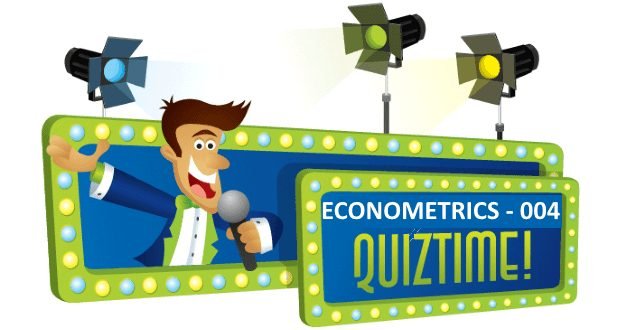500 câu trắc nghiệm Kinh tế lượng – 10B

6) 160 students who were majoring in either math or English were asked a test question, and the
researcher recorded whether they answered the question correctly. The sample results are given below. At the 0.10 significance level, test the claim that response and major are independent.
| Correct | Incorrect | |
| Math | 27 | 53 |
| English | 43 | 37 |
H0: Major and response are independent.
H1: Major and response are dependent.
Test statistic: \({\chi ^2}\) = 6.502. Critical value: \({\chi ^2}\) = 2.706.
Reject the null hypothesis. There is sufficient evidence to warrant rejection of the claim that response and major are independent.
Provide an appropriate response.
7) An observed frequency distribution of exam scores is as follows:
| Exam Score | Under 60 | 60 – 69 | 70 – 79 | 80 – 89 | 90 – 100 |
| Frequency | 36 | 75 | 85 | 70 | 34 |
i) Assuming a normal distribution with m = 75 and s = 15, find the probability of a randomly selected subject belonging to each class. (Use boundaries of 59.5, 69.5, 79.5, 89.5.)
ii) Using the probabilities found in part (i), find the expected frequency for each category.
iii) Use a 0.05 significance level to test the claim that the exam scores were randomly selected from a normally distributed population with m = 75 and s = 15.
i)
| Exam Score | Under 60 | 60 – 69 | 70 – 79 | 80 – 89 | 90 – 100 |
| Probability | 0.1515 | 0.2042 | 0.2622 | 0.2161 | 0.1185 |
ii)
| Exam Score | Under 60 | 60 – 69 | 70 – 79 | 80 – 89 | 90 – 100 |
| Expected Frequency | 45.45 | 61.26 | 78.66 | 64.83 | 35.55 |
iii)
The value of the test statistic is \({\chi ^2}\) = 6.037, which is less than the critical value of \({\chi ^2}\) = 9.488. We fail to reject the null hypothesis that the exam scores are from a normally distributed population.
8) An observed frequency distribution is as follows:
| Number of successes | 0 | 1 | 2 |
| Frequency | 41 | 93 | 66 |
i) Assuming a binomial distribution with n = 2 and p = 1/2, use the binomial formula to find the probability corresponding to each category of the table.
ii) Using the probabilities found in part (i), find the expected frequency for each category.
iii) Use a 0.05 level of significance to test the claim that the observed frequencies fit a binomial distribution for which n = 2 and p = 1/2.
i)
| Number of successes | 0 | 1 | 2 |
| Probability | 0.25 | 0.50 | 0.25 |
ii)
| Number of successes | 0 | 1 | 2 |
| Expected frequency | 50 | 100 | 50 |
iii) H0: p0= 0.25, p1= 0.50, p3= 0.25; H1: At least one of the above probabilities is different from the claimed value. The value of the test statistic is \({\chi ^2}\) = 7.23, which is greater than the critical value of \({\chi ^2}\) = 5.991. We reject the null hypothesis
Solve the problem.
9) A researcher wishes to test the effectiveness of a flu vaccination. 150 people are vaccinated, 180 people are vaccinated with a placebo, and 100 people are not vaccinated. The number in each group who later caught the flu was recorded. The results are shown below.
| Vaccinated | Placebo | Control | |
| Caught the flu | 8 | 19 | 21 |
| Did not catch the flu | 142 | 161 | 79 |
Use a 0.05 significance level to test the claim that the proportion of people catching the flu is the same in all three groups.
H0: The proportion of people catching the flu is the same in all three groups.
H1: The proportions are different.
Test statistic: \({\chi ^2}\) = 14.965. Critical value: \({\chi ^2}\) = 5.991.
Reject the null hypothesis. There is sufficient evidence to warrant rejection of the claim that the proportion of people catching the flu is the same in all three groups
Provide an appropriate response.
10) A survey conducted in a small town yielded the results shown in the table.
| Men | Women | |
| Plan to vote | 105 | 87 |
| Do not plan to vote | 312 | 246 |
i) Test the claim that the intention to vote in the next presidential election is independent of the
gender of the person being surveyed. Use a 0.05 significance level.
ii) Using Yates’ correction, replace \(\sum {\frac{{{{\left( {O – E} \right)}^2}}}{E}} \) with \(\sum {\frac{{{{\left( {\left| {O – E} \right| – 0.5} \right)}^2}}}{E}} \) and repeat the test. What effect does Yates’ correction have on the value of the test statistic?
i) H0: Gender is independent of the intention to vote.
H1: Gender and the intention to vote are dependent.
The value of the test statistic is \({\chi ^2}\) = 0.087, which is less than the critical value of 3.841. We fail to reject the null hypothesis.
ii) The value of the test statistic is \({\chi ^2}\) = 0.044, which is less than the critical value of 3.841. We still fail to reject the null hypothesis. Yates’ correction decreases the value of the test statistic.